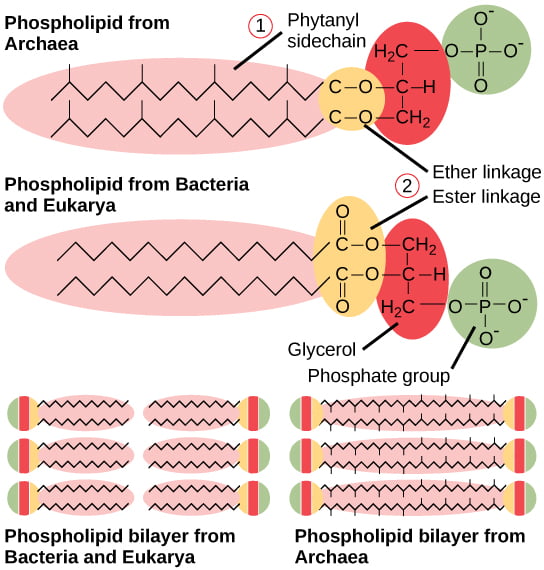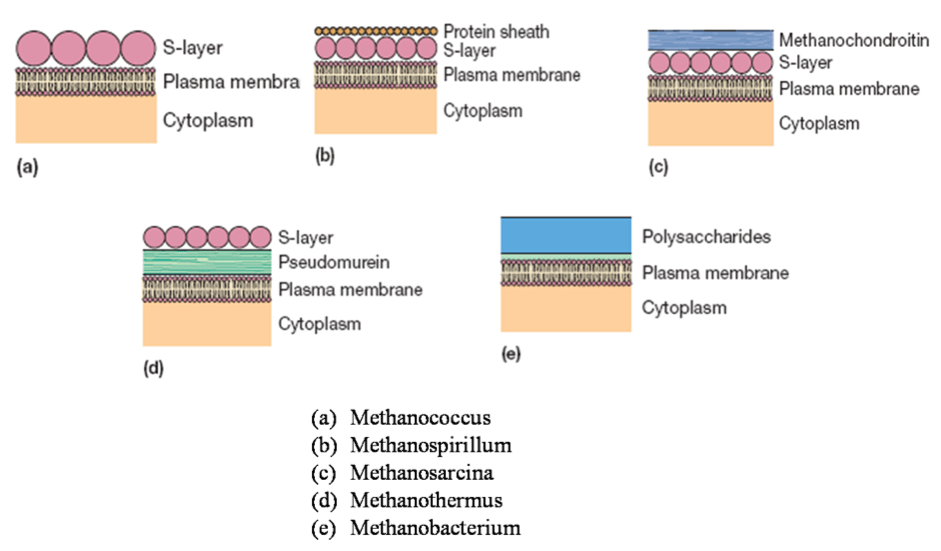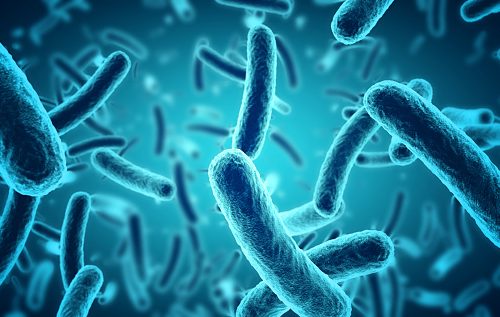Archaebacteria are fascinating microbes and show diverse characteristics. They are unicellular and do not have nucleus and hence scientist thought to categorize them in prokaryotes. When further research was conducted the scientist found that they have few similarities to Eukaryotes. This created a puzzle in the field of classification. To solve the puzzle, the archaea were considered as independent major group. Archaea are also called as an ancient form of life.
Archaebacteria are on earth from almost 3.5 billion years. Many of the Archaebacteria are found in extreme physical conditions like high or low temperature, pH, salt, pressure etc. and hence they are called as extremophiles. To actively operate the physiological and molecular process at such extreme conditions, the Archaebacteria possess peculiar cell wall and enzymes which enables it to survive in extreme conditions.
Phylum of Archaebacteria:
The Archaea, have majorly three phyla – Crenarchaeota, Euryarchaeota, Korarchaeota
Crenarchaeota
The Archaea which has the ability to tolerate extreme high temperature have been categorised in Crenarchaeota. Depending upon the range of temperature, they are further classified as-
- Thermophiles: They live at extreme high temperature. They can grow at and above 100˚ C. They could be found it volcanoes and hot springs. Example – Methanopyrus kandleri
- Mesophiles: They live moderate range of temperature 20- 40oC. They could be found in dairy products. .Example – Listeria monocytogenes
- Psychrophiles: They grow at extremely low temperature i.e. in the range of +10oC to -20oC They are found in north and south pole and other glaciers part of earth..
Example – Chryseobacterium greenlandensis
Euryarchaeota
Methanogens:
- As name suggest, they produce methane from substrates such as H2/CO2, acetate, formate etc These substrate acts like source for both carbon and energy. Most of the methanogens are autotropic.
- Methanobacterium are employed in commercial methane gas production and gobar gas e.g.. Methanobacterium, Methcinococcus.
- They also had been found growing as symbionts inside the rumen of herbivorous animals and play vital role in digesting the cellulose.
Halophiles:
- These archeabacteria can grow in the salt rich (2.5 – 5.0 M) area like salt pans, salt lake, salt marshes and bed.
- They follow chemo-heterotrophic mode of nutrition.
- Presence of special lipids in membrane and mucilage covering allows the halophiles to protect it from plasmolysis.
Thermoacidophile:
- As its name suggest that such Archaebacteria love high temperature upto 80˚C and acidity up to 2 pH
- They follow chemoheterotrophs mode of nutrition.
- They can be aerobic or anerobic.
- The cell envelop and resistant enzymes enable the thermoacidophile to grow in high temperature and low pH
Korarchaeota
The Archaebacteria which shows common and mixed characteristics of crenarchaeota and euryarchaeota are fallen in Korarchaeota.
Morphology of Archaebacteria:
Like bacteria, Archaea also range in the size from 0.5 – 4 µm. It has been found that they could be either extremely small or extremely large in size. The smallest archaeans cannot be studied even in the high power light microscope. They look like tiny dots in light microscope and hence electron microscope is employed to observe and study such tiny archaeans
Similar to bacteria, the Archaea also exhibit circular, rod, spiral and pleomorphic shapes. So far scientist has not found spirochete shaped Archaea. A special type of flat (postage stamp like) shape have found in salt ponds (halophile – salt loving). The flat structure increases S/V ratio which had advantage of escalating the efficiency of nutrient uptake, osmo regulation and growth rate.
Archaebacteria Cell Organization:
Alike bacteria, the Archaebacteria also lack membrane bound organelles. Archaebacteria also contain nucleoid, ribosomes, inclusion bodies and locomotary organelle as found in bacteria. Let’s see what characteristics of Archaebacteria make it different from bacteria and allow it to grow and flourish in extreme conditions.
Cell envelop:
The cell envelop consists of cell membrane, cell wall and other outer layers (S-layer, capsule and slime, as discussed earlier in Bacteria chapter).
Cell membrane:
The distinctive characteristic of Archaea is that its cell membrane is made from mono layer of lipid (if you remember in bacteria it is double layer of lipid explained in fluid mosaic model). Though the membrane is monolayer but it function is similar to bilayer. This is because of special lipid with ether linkages (In bacteria, the lipids contains ester linkages). Due to the ether bonds, the monoloyers are much more heat stable compared to bacterial cell membrane. Similar to bacteria, the hydrophilic part (glycerol) is at cytoplasmic side whereas, the hydrophobic part (Fatty acid hydrocarbon chains) are at the exterior side.
The unique characteristic is that the glycerol present in lipid is ‘L‘stereoisomer where as in Bacteria is ‘D’ chain present in Archaea. The fatty acid chains in Archaea are branched isoprene whereas in bacteria the fatty acids are linear chains.

Cell wall:
The cell wall defines the shape and gives rigidity. The cell wall play major role in maintaining the cytoplasmic solute concentration and protect from osmotic pressure.
Like cell membrane composition, the cell wall composition of Archaea also differs from bacterial cell wall.
As studied earlier, the bacterial cell wall is made up of peptidoglycan, which contains polysaccharide chains of alternate N-acetyl glucosamine (NAG) and N-acetyl Muramic acid (NAM). The NAM monomers are linked to short peptide chains and these short peptide chains are crosslinked by glycine (usually 5 in number). But the Archaea lack such peptidoglycan structure. In place of peptidoglycan, the Archaea may have pseudopeptidoglycan, polysaccharide, glycoprotein or protein. The pseudopeptidoglycan (pseudomurein) is made from different types of sugar monomer like N-acetyltalosaminuronic acid (NAT) and N-acetyl glucosamine (NAG) connected through β (1→3) glycosidic linkages.
The different envelop found in Archaea bacteria are mentioned in the below diagram

Nucleoid
Like bacteria, Archaebacteria do not have membrane bound organelle and hence it lack defined nucleus structure. The irregular shaped region, where the genetic material i.e. double stranded DNA is present is called as nucleoid. It has been found that few Archaebacteria contains more than one copy of their chromosome (i.e. polyploidy). In different phyla of Archaebacteria, the HU protein, Alba or Histone proteins have been found to be involved in DNA folding and forming its compact structure.
Ribosome:
Archaebacteria also contains 50S and 30S ribosome that constitutes 70S. The ribsomes are made from rRNA and proteins. The smaller subunit contains 16S rRNA and the larger unit contains 23S, 5S and 5.8S (bacteria contain 23S and 5S only in its large subunit of ribosome). The major difference between Archaea and bacteria in terms of ribosome is the sequence of rRNA. This is significant reason for which Archaea has become separate taxon. The ribosomal proteins also differ in bacteria and Archaea.
Flagella and Pilli:
So far, we have not completely understood the structure and mechanism of pilli and flagella of Archaebacteria. It has been found that pilli and flagella of Archaea are made from type IV pilli proteins.
References-
https://ucmp.berkeley.edu/archaea/archaea.html
https://www.cliffsnotes.com/study-guides/biology/microbiology/the-bacteria/
Dr. Sangha Bijekar has 9 years of Teaching Experience at University level. She loves to get engage in teaching and learning process. She is into blogging from last two years. She intends to provide student friendly reading material. She is avid Dog Lover and animal rescuer. She is learned Bharatnatyam and Katthak Dancer. She is into biking and She also loves to cook.


